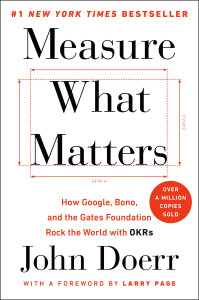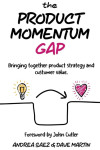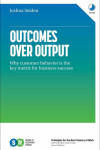Measure what matters
How Google, Bono, and the Gates Foundation Rock the World with OKRs
"Measure What Matters" introduces and explains the OKR (Objectives and Key Results) framework, a goal-setting system used by companies like Intel and Google. The book demonstrates how OKRs can transform goal-setting from an annual exercise into a dynamic, ongoing process that drives engagement and achievement.
Through case studies and practical examples, Doerr shows how OKRs help organizations focus on the highest-value goals while providing a clear framework for measuring progress. The book explains how this system creates alignment between teams, encourages ambitious goal-setting, and maintains accountability through regular check-ins and transparent tracking.
The book also introduces CFRs (Conversations, Feedback, and Recognition) as a complementary system to OKRs, showing how continuous performance management can replace traditional annual reviews and create a more dynamic, growth-oriented culture.
By reading "Measure What Matters," you will:
- Master the OKR framework: Learn to create meaningful objectives with measurable key results that drive real organizational change.
- Implement effective goal-setting practices: Understand how to cascade goals throughout an organization while maintaining autonomy and engagement.
- Transform performance management: Replace annual reviews with continuous feedback systems that encourage growth and development.
- Create a culture of accountability: Develop transparent tracking systems that keep teams aligned and focused on what matters most.
Books to Follow
- "High Output Management" by Andy Grove - Provides deeper context on Intel's management philosophy where OKRs originated
- "Radical Focus" by Christina Wodtke - Offers practical implementation of OKRs through story format
- "Good to Great" by Jim Collins - Explores how disciplined goal-setting and execution drive organizational success
- "Drive" by Daniel Pink - Examines the motivational aspects of goal-setting and performance
1. OKR Structure
Objectives are ambitious, qualitative goals that answer “what” needs to be achieved. Key Results are specific, measurable outcomes that answer “how” we’ll achieve the objective. For example:
- Objective: Establish market leadership in user experience
- Key Results:
- Achieve 95% customer satisfaction score
- Reduce user error rate by 50%
- Decrease average task completion time by 30%
2. Focus and Commitment
Organizations should limit themselves to 2-3 objectives with 3-5 key results each per quarter. This constraint forces prioritization and ensures focus on what truly matters. Google differentiates between “committed” OKRs (expected to be achieved 100%) and “aspirational” OKRs (stretch goals with 60-70% achievement target).
3. Transparency and Alignment
OKRs should be public and accessible to everyone in the organization. This visibility creates alignment and enables teams to coordinate efforts effectively. Individual and team OKRs should connect to company-level objectives while maintaining autonomy in execution.
4. Regular Check-ins
Progress should be reviewed frequently (typically monthly) with the ability to adjust course as needed. OKRs use a 0-1.0 scoring system:
- 0.7-1.0: Green (Target achieved)
- 0.4-0.6: Yellow (Progress made)
- 0.0-0.3: Red (Failed to make significant progress)
5. CFR Framework
Conversations, Feedback, and Recognition (CFR) complement OKRs by providing continuous performance management:
- Conversations: Regular check-ins about progress and development
- Feedback: Bidirectional, specific guidance for improvement
- Recognition: Acknowledging and rewarding achievement
Q: How many OKRs should an organization have?
A: At the organizational level, limit to 2-3 objectives with 3-5 key results each. Teams and individuals should similarly constrain their OKRs to maintain focus and prevent dilution of effort.
Q: How often should OKRs be set and reviewed?
A: Most organizations set OKRs quarterly with monthly check-ins. However, the cadence can be adjusted based on business needs. Some startups use monthly OKRs during rapid growth phases.
Q: What’s the difference between committed and aspirational OKRs?
A: Committed OKRs are expected to be achieved 100% of the time and often relate to core business functions. Aspirational OKRs are stretch goals where 60-70% achievement is considered successful.
Q: How do you handle OKRs that become irrelevant mid-cycle?
A: OKRs can be modified or abandoned if business conditions change significantly. The key is to document the reasoning and learnings, then create new OKRs that better reflect current priorities.
Q: Should OKRs be tied to compensation?
A: Doerr recommends separating OKRs from compensation decisions, particularly for aspirational OKRs. This separation encourages ambitious goal-setting without fear of penalty for falling short.
Q: How do you create good Key Results?
A: Good Key Results are specific, measurable, time-bound, and verifiable. They should be outcomes rather than activities, answering the question “how will we know we’ve achieved our objective?”
- When implementing goal-setting systems: You need a framework to align your organization’s objectives and measure progress effectively.
- During rapid growth phases: Your organization needs better alignment and clear priorities as it scales.
- When transforming performance management: You want to move from annual reviews to continuous feedback and development.
- Before strategic planning: You need tools to translate high-level strategy into measurable actions across the organization.

Your support helps me maintain and improve the book recommendations for everyone.






